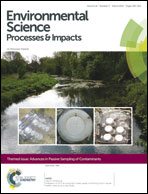Field dissipation and plant uptake of benzotriazole ultraviolet stabilizers in biosolid-amended soils†
Abstract
Benzotriazole ultraviolet stabilizers (BUVSs) have been commonly used in industrial and household product formulations, and have been detected in biosolids from wastewater treatment plants. However, little is known about their occurrence and dissipation behavior in the soil environment associated with biosolid application. This study investigated the occurrence and dissipation of five typical BUVSs (UV-326, UV-327, UV-328, UV-329 and UV-P) in biosolid-amended soils, and the uptake of these biocides by plants. The field trial includes two treatment groups: old groups with biosolid application at rates of 5, 10, 20 and 40 t ha−1 every year within 5 years, and new groups with only one biosolid application. The results showed that the five BUVSs could be detected in most biosolid-amended soils at a few to tens of ng g−1 levels, but not detected in the control soils. These chemicals were not found in the crop plants collected from the trial plots. Moreover, high biosolid application rates and repeated biosolid applications resulted in high accumulation of these BUVSs in soil. During one year monitoring, the five BUVSs were significantly dissipated in the biosolid-amended soils with their half-lives ranging from 79 to 223 days, which were comparable with the modeling results. The results from this study demonstrated the persistence of BUVSs in soil environments with quite slow dissipation rates.


 Please wait while we load your content...
Please wait while we load your content...